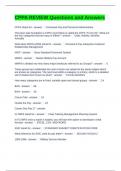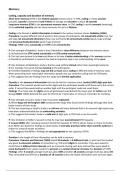HEP4211
Changing Health Behavior
Summary lecture: Risk perception 1
Presentation of risk information 1
Narrative techniques 4
Fear appeals 6
Summary lecture: Attitude 9
Gain framed versus loss framed arguments 9
Cognitive versus affective arguments 10
Processing of arguments: ELM 12
Summary lecture: Self-efficacy 15
Enactive mastery 15
Vicarious experience/modelling/observational learning 17
Self-monitoring and feedback 19
Summary lecture: Automaticity 21
Action and coping planning 21
Retraining 24
Summary lecture: Micro environment 27
Parenting 29
Social support 31
Nudging 34
Summary lecture: Macro environment 36
Availability regulations 36
Taxation 37
Social Norms Approach (SNA) 38
, Summary lecture: Risk perception
Risk perception is incorporated in many (health) behavior change theories, such as:
• Protection Motivation Theory
• Health Belief Model
• I-Change Model
• Health Action Process Approach, etc.
It is seen as a precondition for motivation and informed decision making. People are more
motivated to behave healthy if they perceive themselves to be at risk. You need adequate
knowledge of the risk to be able to make an informed decision.
Risk perception = severity + susceptibility.
→ Behavior isn’t only based on cognitive judgements (what people think), but even more on
affective likelihood beliefs (what people feel).
Risk communication goals:
• Behavior change (people do not seem to perceive the risk)
• Provide reassurance when people are outraged/far more concerned than expected based on
a scientific point of view
• To inform people so that they can make informed decisions (informed decision making)
→ Goal: to reach accurate risk perceptions of risk (not necessarily ‘higher perceived risk’)
and enable people to make an informed decision.
The perception of risk likelihood can guide (health-protective) behavior. People are
often unrealistically optimistic (=optimistic bias) about their vulnerability and underestimate
their likelihood, especially when the risk is partly controllable. Therefore, risk information
is often included in health interventions to influence individuals’ risk perception.
→ Not a one-size-fits-all way.
Probability estimates are affected by:
• Cognitive capacities and characteristics of the person who is receiving the message (e.g.
numeracy, graph literacy).
• Context (e.g. the place where the message is given).
• Risk perception methods (e.g. formats, framing).
→ Affect motivation and ability of people to process information: central/systematic vs.
peripheral/heuristic → the more central (deliberately) the processing of the message, the
higher the likelihood that people accept the message and will take action.
Presentation of risk information
The communication of risk information is a fundamental aspect of nearly all health
promotion interventions. However, no consensus exists regarding the most effective
way to provide people with risk information. Two approaches to risk communication:
• Numerical probability-based approach = presentation of numerical information
regarding the probability of a risk/health problem occurring.
o Provides precise information regarding probabilities.
o Effectiveness is limited, since people have difficulty understanding and using
quantitative data → cognitive (misunderstanding of information) and motivational
(people mostly engage with favourable information) barriers. It can increase public
awareness of potential health problems, but it doesn’t affect perceptions of personal risk
that much.
• Contextualized approach = presentation of informational context (antecedents and/or
consequences of a health problem) in which to understand and interpret individual risk.
1
Changing Health Behavior
Summary lecture: Risk perception 1
Presentation of risk information 1
Narrative techniques 4
Fear appeals 6
Summary lecture: Attitude 9
Gain framed versus loss framed arguments 9
Cognitive versus affective arguments 10
Processing of arguments: ELM 12
Summary lecture: Self-efficacy 15
Enactive mastery 15
Vicarious experience/modelling/observational learning 17
Self-monitoring and feedback 19
Summary lecture: Automaticity 21
Action and coping planning 21
Retraining 24
Summary lecture: Micro environment 27
Parenting 29
Social support 31
Nudging 34
Summary lecture: Macro environment 36
Availability regulations 36
Taxation 37
Social Norms Approach (SNA) 38
, Summary lecture: Risk perception
Risk perception is incorporated in many (health) behavior change theories, such as:
• Protection Motivation Theory
• Health Belief Model
• I-Change Model
• Health Action Process Approach, etc.
It is seen as a precondition for motivation and informed decision making. People are more
motivated to behave healthy if they perceive themselves to be at risk. You need adequate
knowledge of the risk to be able to make an informed decision.
Risk perception = severity + susceptibility.
→ Behavior isn’t only based on cognitive judgements (what people think), but even more on
affective likelihood beliefs (what people feel).
Risk communication goals:
• Behavior change (people do not seem to perceive the risk)
• Provide reassurance when people are outraged/far more concerned than expected based on
a scientific point of view
• To inform people so that they can make informed decisions (informed decision making)
→ Goal: to reach accurate risk perceptions of risk (not necessarily ‘higher perceived risk’)
and enable people to make an informed decision.
The perception of risk likelihood can guide (health-protective) behavior. People are
often unrealistically optimistic (=optimistic bias) about their vulnerability and underestimate
their likelihood, especially when the risk is partly controllable. Therefore, risk information
is often included in health interventions to influence individuals’ risk perception.
→ Not a one-size-fits-all way.
Probability estimates are affected by:
• Cognitive capacities and characteristics of the person who is receiving the message (e.g.
numeracy, graph literacy).
• Context (e.g. the place where the message is given).
• Risk perception methods (e.g. formats, framing).
→ Affect motivation and ability of people to process information: central/systematic vs.
peripheral/heuristic → the more central (deliberately) the processing of the message, the
higher the likelihood that people accept the message and will take action.
Presentation of risk information
The communication of risk information is a fundamental aspect of nearly all health
promotion interventions. However, no consensus exists regarding the most effective
way to provide people with risk information. Two approaches to risk communication:
• Numerical probability-based approach = presentation of numerical information
regarding the probability of a risk/health problem occurring.
o Provides precise information regarding probabilities.
o Effectiveness is limited, since people have difficulty understanding and using
quantitative data → cognitive (misunderstanding of information) and motivational
(people mostly engage with favourable information) barriers. It can increase public
awareness of potential health problems, but it doesn’t affect perceptions of personal risk
that much.
• Contextualized approach = presentation of informational context (antecedents and/or
consequences of a health problem) in which to understand and interpret individual risk.
1



